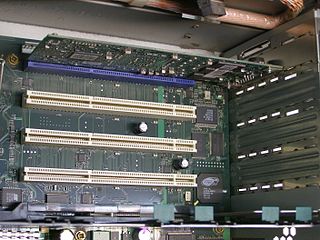
OpenStep is an object-oriented application programming interface (API) specification that was developed by NeXT Computer. It provides a framework for building graphical user interfaces (GUIs) and developing software applications. OpenStep was designed to be platform-independent, allowing developers to write code that could run on multiple operating systems, including NeXTSTEP, Windows NT, and various Unix-based systems. It has influenced the development of other GUI frameworks, such as Cocoa for macOS and GNUstep.
The 88000 is a RISC instruction set architecture developed by Motorola during the 1980s. The MC88100 arrived on the market in 1988, some two years after the competing SPARC and MIPS. Due to the late start and extensive delays releasing the second-generation MC88110, the m88k achieved very limited success outside of the MVME platform and embedded controller environments. When Motorola joined the AIM alliance in 1991 to develop the PowerPC, further development of the 88000 ended.

In computing, an expansion card is a printed circuit board that can be inserted into an electrical connector, or expansion slot on a computer's motherboard to add functionality to a computer system. Sometimes the design of the computer's case and motherboard involves placing most of these slots onto a separate, removable card. Typically such cards are referred to as a riser card in part because they project upward from the board and allow expansion cards to be placed above and parallel to the motherboard.
HyperTransport (HT), formerly known as Lightning Data Transport, is a technology for interconnection of computer processors. It is a bidirectional serial/parallel high-bandwidth, low-latency point-to-point link that was introduced on April 2, 2001. The HyperTransport Consortium is in charge of promoting and developing HyperTransport technology.

PCI Express, officially abbreviated as PCIe or PCI-e, is a high-speed serial computer expansion bus standard, designed to replace the older PCI, PCI-X and AGP bus standards. It is the common motherboard interface for personal computers' graphics cards, sound cards, hard disk drive host adapters, SSDs, Wi-Fi and Ethernet hardware connections. PCIe has numerous improvements over the older standards, including higher maximum system bus throughput, lower I/O pin count and smaller physical footprint, better performance scaling for bus devices, a more detailed error detection and reporting mechanism, and native hot-swap functionality. More recent revisions of the PCIe standard provide hardware support for I/O virtualization.

VMEbus is a computer bus standard physically based on Eurocard sizes.

The Scalable Coherent Interface or Scalable Coherent Interconnect (SCI), is a high-speed interconnect standard for shared memory multiprocessing and message passing. The goal was to scale well, provide system-wide memory coherence and a simple interface; i.e. a standard to replace existing buses in multiprocessor systems with one with no inherent scalability and performance limitations.

Norsk Data was a minicomputer manufacturer located in Oslo, Norway. Existing from 1967 to 1998, it had its most active period from the early 1970s to the late 1980s. At the company's peak in 1987, it was the second largest company in Norway and employed over 4,500 people.

Quadrics was a supercomputer company formed in 1996 as a joint venture between Alenia Spazio and the technical team from Meiko Scientific. They produced hardware and software for clustering commodity computer systems into massively parallel systems. Their highpoint was in June 2003 when six out of the ten fastest supercomputers in the world were based on Quadrics' interconnect. They officially closed on June 29, 2009.
Aviion was a series of computers from Data General that were the company's main product from the late 1980s until the company's server products were discontinued in 2001. Earlier Aviion models used the Motorola 88000 CPU, but later models moved to an all-Intel solution when Motorola stopped work on the 88000 in the early 1990s. Some versions of these later Intel-based machines ran Windows NT, while higher-end machines ran the company's flavor of Unix, DG/UX.

PCI-X, short for Peripheral Component Interconnect eXtended, is a computer bus and expansion card standard that enhances the 32-bit PCI local bus for higher bandwidth demanded mostly by servers and workstations. It uses a modified protocol to support higher clock speeds, but is otherwise similar in electrical implementation. PCI-X 2.0 added speeds up to 533 MHz, with a reduction in electrical signal levels.

The RapidIO architecture is a high-performance packet-switched electrical connection technology. It supports messaging, read/write and cache coherency semantics. Based on industry-standard electrical specifications such as those for Ethernet, RapidIO can be used as a chip-to-chip, board-to-board, and chassis-to-chassis interconnect.
The HP StorageWorks IO Accelerator is a type of solid-state drive in a mezzanine card form factor for HP's BladeSystem c-Class servers. This product was announced by HP on March 2, 2009. The follow-on product, the HP StorageWorks PCIe IO Accelerator for Proliant Servers is a standard PCIe form factor, and is supported in a variety of Proliant DL and ML servers.

The MC88110 was a microprocessor developed by Motorola that implemented the 88000 instruction set architecture (ISA). The MC88110 was a second-generation implementation of the 88000 ISA, succeeding the MC88100. It was designed for use in personal computers and workstations.
NVM Express (NVMe) or Non-Volatile Memory Host Controller Interface Specification (NVMHCIS) is an open, logical-device interface specification for accessing a computer's non-volatile storage media usually attached via the PCI Express bus. The initial NVM stands for non-volatile memory, which is often NAND flash memory that comes in several physical form factors, including solid-state drives (SSDs), PCIe add-in cards, and M.2 cards, the successor to mSATA cards. NVM Express, as a logical-device interface, has been designed to capitalize on the low latency and internal parallelism of solid-state storage devices.

Integrated Device Technology, Inc. (IDT), was an American semiconductor company headquartered in San Jose, California. The company designed, manufactured, and marketed low-power, high-performance mixed-signal semiconductor products for the advanced communications, computing, and consumer industries. The company marketed its products primarily to original equipment manufacturers (OEMs). Founded in 1980, the company began as a provider of complementary metal-oxide semiconductors (CMOS) for the communications business segment and computing business segments. The company focused on three major areas: communications infrastructure, high-performance computing, and advanced power management. Between 2018 and 2019, IDT was acquired by Renesas Electronics.

M.2, pronounced m dot two and formerly known as the Next Generation Form Factor (NGFF), is a specification for internally mounted computer expansion cards and associated connectors. M.2 replaces the mSATA standard, which uses the PCI Express Mini Card physical card layout and connectors. Employing a more flexible physical specification, M.2 allows different module widths and lengths, which, paired with the availability of more advanced interfacing features, makes M.2 more suitable than mSATA in general for solid-state storage applications, particularly in smaller devices such as ultrabooks and tablets.

SATA Express is a computer bus interface that supports both Serial ATA (SATA) and PCI Express (PCIe) storage devices, initially standardized in the SATA 3.2 specification. The SATA Express connector used on the host side is backward compatible with the standard SATA data connector, while it also provides two PCI Express lanes as a pure PCI Express connection to the storage device.
Coherent Accelerator Processor Interface (CAPI), is a high-speed processor expansion bus standard for use in large data center computers, initially designed to be layered on top of PCI Express, for directly connecting central processing units (CPUs) to external accelerators like graphics processing units (GPUs), ASICs, FPGAs or fast storage. It offers low latency, high speed, direct memory access connectivity between devices of different instruction set architectures.
Compute Express Link (CXL) is an open standard for high-speed, high capacity central processing unit (CPU)-to-device and CPU-to-memory connections, designed for high performance data center computers. CXL is built on the serial PCI Express (PCIe) physical and electrical interface and includes PCIe-based block input/output protocol (CXL.io) and new cache-coherent protocols for accessing system memory (CXL.cache) and device memory (CXL.mem). The serial communication and pooling capabilities allows CXL memory to overcome performance and socket packaging limitations of common DIMM memory when implementing high storage capacities.













